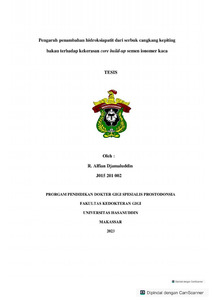Djamaluddin, R. Alfian (2023) Pengaruh penambahan hidroksiapatit dari serbuk cangkang kepiting bakau terhadap kekerasan core build-up semen ionomer kaca. Skripsi thesis, Universitas Hasanuddin.
![[thumbnail of J015201002_tesis_14-07-2023 cover1.png]](/30974/1.hassmallThumbnailVersion/J015201002_tesis_14-07-2023%20cover1.png)

J015201002_tesis_14-07-2023 cover1.png
Download (255kB) | Preview
J015201002_tesis_14-07-2023 dp.pdf
Download (1MB)
J015201002_tesis_14-07-2023 1-2.pdf
Download (5MB)
J015201002_tesis_14-07-2023.pdf
Restricted to Repository staff only until 1 January 2025.
Download (8MB)
Abstract (Abstrak)
Background: Glass Ionomer Cement (GIC) is a material that is able to bond chemically to dentin and enamel. Core build-up made from Glass Ionomer Cement type 6 is significantly weaker than composite resin and amalgam materials, so
modifications are needed. Several attempts have been made to improve the mechanical properties of GIC, such as modifying the GIC incorporation by adding fillers in the form of stainless steel, glass fiber and hydroxyapatite. Hydroxyapatite is the most stable bioceramic of the calcium phosphate group and is the main mineral that makes up bones and teeth. Natural sources of calcium that can be used
for the synthesis of hydroxyapatite have high levels of calcium, one of which is crab shells. Crab shell waste contains a fairly high calcium compound (CaCO3), which
is around 53-78% of the weight of the dry shell.
Objective: To test the hardness of core build-up from glass ionomer cement with the addition of hydroxyapatite from mud crab shell powder (Scylla serrata).
Method: This research was an experimental laboratory study, with the post test only control group design. The sample in this study was divided into 5 treatment groups, namely the GIC group without the addition of Hydroxyapatite, and the ratio of 6%, 7%, 8% and 9% hydroxyapatite and GIC. The microhardness level of GIC modified crab shell hydroxyapatite material was measured using the Micro Vickers
Hardness Tester.
Results: The average hardness in the control group (0%) was 28.68 HV, in the treatment group (6%, 7%, 8% and 9%) were respectively 25.18 HV, 28.08 HV, 30 .92, and 34.34 HV. Based on the ANOVA test, the value of p <0.05 was obtained,
and the Person Correlation was p <0.05 in the 8% and 9% groups.
Conclusion: There is a significant difference in the core build-up hardness of glass ionomer cement with the addition of hydroxyapatite compared to without the addition, and a positive correlation indicates that the higher the hydroxyapatite concentration, the core build-up hardness of glass ionomer cement also increases Keywords: Hydroxyapatite, Mud crab, GIC, Core build up, Hardness
| Item Type: | Thesis (Skripsi) |
|---|---|
| Subjects: | R Medicine > RK Dentistry |
| Divisions (Program Studi): | Fakultas Pendidikan Dokter Gigi > PPDGS - Prostodonsia |
| Depositing User: | Nasyir Nompo |
| Date Deposited: | 19 Feb 2024 07:14 |
| Last Modified: | 19 Feb 2024 07:14 |
| URI: | http://repository.unhas.ac.id:443/id/eprint/30974 |


